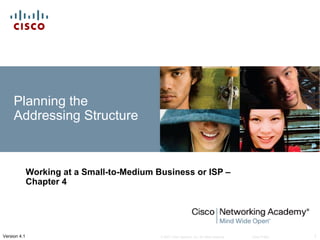More Related Content
Similar to CCNA Discovery 2 - Chapter 4 (20)
More from Irsandi Hasan (20)
CCNA Discovery 2 - Chapter 4
- 1. Planning the
Addressing Structure
Working at a Small-to-Medium Business or ISP –
Chapter 4
Version 4.1 © 2007 Cisco Systems, Inc. All rights reserved. Cisco Public 1
- 2. Objectives
Describe how IP Addressing is implemented in the
LAN.
Subnet a given network to allow for efficient use of IP
address space.
Explain how Network Address Translation (NAT) and
Port Address Translation (PAT) are used in a network.
© 2007 Cisco Systems, Inc. All rights reserved. Cisco Public 2
- 3. IP Addressing in the LAN
IP addressing identifies hosts and network devices
IP address format: dotted-decimal notation
Hierarchical structure: network and host octets
© 2007 Cisco Systems, Inc. All rights reserved. Cisco Public 3
- 4. IP Addressing in the LAN
Address classes A, B and C: used to identify hosts or
networks
Address classes D and E: multicast and experimental
uses
© 2007 Cisco Systems, Inc. All rights reserved. Cisco Public 4
- 5. IP Addressing in the LAN
First octet bit patterns and classes:
Class A: first bit is always 0
Class B: first two bits are always 1 and 0
Class C: first three bits are always 1, 1 and 0
© 2007 Cisco Systems, Inc. All rights reserved. Cisco Public 5
- 6. IP Addressing in the LAN
Reserved address space for private networks
Private IPs are not routable on the Internet
Consumer networking devices give out private IPs
through DHCP
© 2007 Cisco Systems, Inc. All rights reserved. Cisco Public 6
- 7. IP Addressing in the LAN
RFC 917, Internet Subnets
Subnet mask separates network bits from host bits
Routers read subnet masks left to right, bit for bit
– Bits set to 1 are part of the network ID
– Bits set to 0 are part of the host ID
© 2007 Cisco Systems, Inc. All rights reserved. Cisco Public 7
- 8. IP Addressing in the LAN
Classful subnetting:
Use bits from the host space to designate a
subnet ID
All resulting subnets use the same subnet ID
© 2007 Cisco Systems, Inc. All rights reserved. Cisco Public 8
- 9. IP Addressing in the LAN
Classless subnetting features:
CIDR: identify networks based on the number of bits in
the network prefix
VLSM: divide address space into networks of various
sizes
© 2007 Cisco Systems, Inc. All rights reserved. Cisco Public 9
- 10. IP Addressing in the LAN
Communicating between subnets:
Each subnet is a separate network
Router is needed to communicate between them
Each router interface is the default gateway for its
subnet
© 2007 Cisco Systems, Inc. All rights reserved. Cisco Public 10
- 11. NAT and PAT
Network address translation (NAT) allows private users
to access the Internet by sharing one or more public IP
addresses
© 2007 Cisco Systems, Inc. All rights reserved. Cisco Public 11
- 12. NAT and PAT
NAT operation is transparent to users
Benefits include improved security and scalability
© 2007 Cisco Systems, Inc. All rights reserved. Cisco Public 12
- 13. NAT and PAT
Inside local network
Outside global network
© 2007 Cisco Systems, Inc. All rights reserved. Cisco Public 13
- 14. NAT and PAT
Dynamic NAT assigns outside global addresses from a
pre-defined pool
Static NAT assigns a permanent registered global IP to
an individual private host IP
© 2007 Cisco Systems, Inc. All rights reserved. Cisco Public 14
- 15. NAT and PAT
PAT translates multiple local addresses to a single
global IP address
© 2007 Cisco Systems, Inc. All rights reserved. Cisco Public 15
- 16. NAT and PAT
PAT conversations use a unique temporary IP address
and port number combination
Port numbers above 1024
Maximizes use of addresses and security
© 2007 Cisco Systems, Inc. All rights reserved. Cisco Public 16
- 17. NAT and PAT
IP Nat issues:
Additional workload to support IP addresses and port
translations
Careful network design and equipment selection
Accurate configuration
© 2007 Cisco Systems, Inc. All rights reserved. Cisco Public 17
- 18. NAT and PAT
Temporary solutions to address depletion: subnetting,
private IP addressing, and NAT
Improvements proposed by using IPv6:
– More address space and better space management
– Easier administration
– Support for advanced network capabilities
© 2007 Cisco Systems, Inc. All rights reserved. Cisco Public 18
- 19. NAT and PAT
IPv6 address notation:
128 bits
32 hexadecimal digits
Three-part hierarchy: global prefix, subnet and
interface ID
© 2007 Cisco Systems, Inc. All rights reserved. Cisco Public 19
- 20. Summary
IP addressing can be tailored to the needs of the
network design through the use of custom subnet
masks.
Classless subnetting gives classful IP addressing
schemes more flexibility through the use of variable
length subnet masks.
Network Address Translation (NAT) is a way to shield
private addresses from outside users.
Port Address Translation (PAT) translates multiple local
addresses to a single global IP address, maximizing the
use of both private and public IP addresses.
© 2007 Cisco Systems, Inc. All rights reserved. Cisco Public 20
- 21. © 2007 Cisco Systems, Inc. All rights reserved. Cisco Public 21

